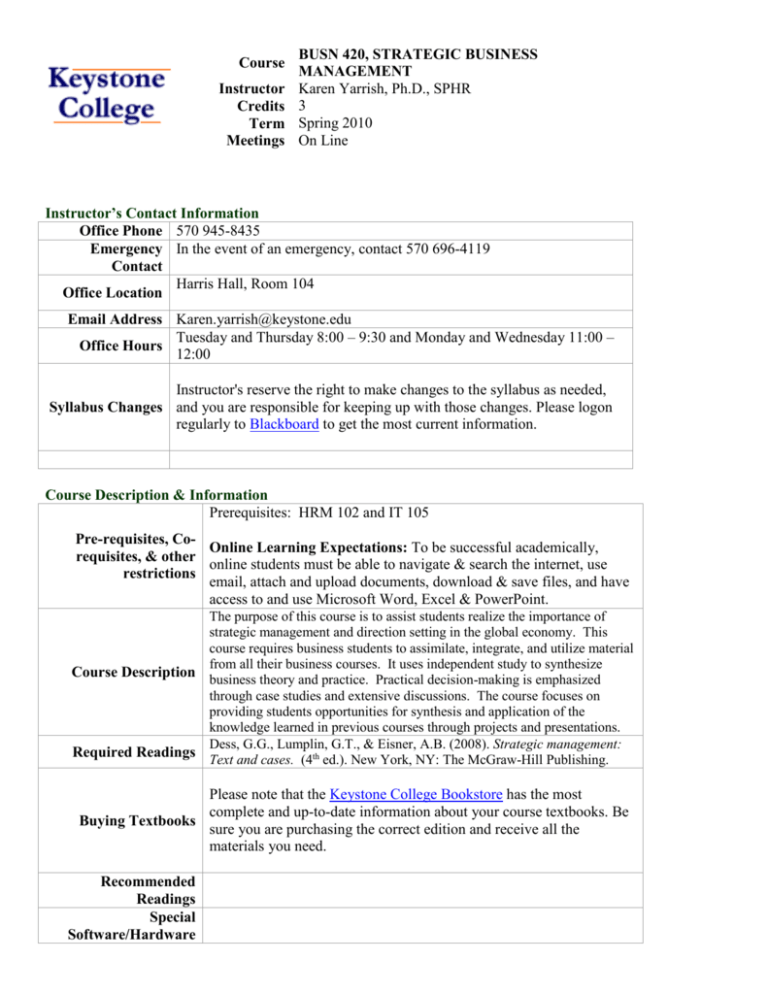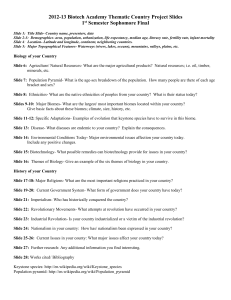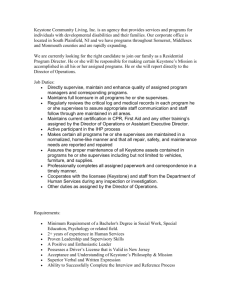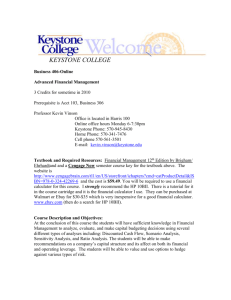Bus 420 Syllabus
advertisement

Course Instructor Credits Term Meetings BUSN 420, STRATEGIC BUSINESS MANAGEMENT Karen Yarrish, Ph.D., SPHR 3 Spring 2010 On Line Instructor’s Contact Information Office Phone 570 945-8435 Emergency In the event of an emergency, contact 570 696-4119 Contact Harris Hall, Room 104 Office Location Email Address Karen.yarrish@keystone.edu Tuesday and Thursday 8:00 – 9:30 and Monday and Wednesday 11:00 – Office Hours 12:00 Instructor's reserve the right to make changes to the syllabus as needed, Syllabus Changes and you are responsible for keeping up with those changes. Please logon regularly to Blackboard to get the most current information. Course Description & Information Prerequisites: HRM 102 and IT 105 Pre-requisites, CoOnline Learning Expectations: To be successful academically, requisites, & other online students must be able to navigate & search the internet, use restrictions email, attach and upload documents, download & save files, and have access to and use Microsoft Word, Excel & PowerPoint. The purpose of this course is to assist students realize the importance of strategic management and direction setting in the global economy. This course requires business students to assimilate, integrate, and utilize material from all their business courses. It uses independent study to synthesize Course Description business theory and practice. Practical decision-making is emphasized through case studies and extensive discussions. The course focuses on providing students opportunities for synthesis and application of the knowledge learned in previous courses through projects and presentations. Dess, G.G., Lumplin, G.T., & Eisner, A.B. (2008). Strategic management: Required Readings Text and cases. (4th ed.). New York, NY: The McGraw-Hill Publishing. Please note that the Keystone College Bookstore has the most complete and up-to-date information about your course textbooks. Be Buying Textbooks sure you are purchasing the correct edition and receive all the materials you need. Recommended Readings Special Software/Hardware For standard Browser/Plugin/Viewer visit this page: http://web.keystone.edu/library/syllabus/browser.htm Browser/Plugin/Viewer or add your own info below Info Other Required Materials Course Goals, Objectives/Outcomes Learning Outcomes The goal of this course is for each student to develop a basic understanding of the strategic levels of business as it applies to the effectiveness of management and leadership in successful for-profit and non-profit organizations. 1. Demonstrate extensive knowledge and comprehension of business policies and strategies. 2. Utilize the strategic management process in the application of business principles. 3. Apply and analyze business strategies through a case study process 4. Analyze current business issues as found in appropriate printed media. 5. Integrate business strategies through the development and presentation of a comprehensive research paper.. Grading Case Analyses and Presentation 180 points Research Paper/Project Presentation – 115 points End of Chapter Discussion Questions – 50 points Grading (credit) Criteria A variety of assignments will be administered during the semester. Assignments Separate instruction and grading sheets will be provided. All written assignments should be sent via email. Weekly Discussion Criteria Discussion Board Criteria The discussion weeks in this course will run from Noon on Saturdays through Fridays at 11:59 p.m. HOW DOES DISCUSSION WORK IN THIS COURSE? An overview of the week’s topic will be posted on Saturday of each week, along with questions for discussion. Your Attendance & Participation/Weekly Discussion grade is based on your response to these questions and to your classmates throughout each week. Whereas in a classroom you would listen to what your classmates have to say, in an online class, you have to read what they have to say. Therefore, you are responsible for reading every message posted on Blackboard, whether you think it pertains to you or not. Doing this not only helps you to understand the material better, but many times I will answer questions or bring up important material in a response to another student and it may not come up elsewhere. WHAT DO I HAVE TO DO? Every week, you are expected at minimum, to: submit at least one substantive post (response) per discussion week. Substantive means that you must take time in formulating your response, organizing your own thoughts and incorporating the reading materials (you should be citing parts of the book or other reading materials in your posts). You must demonstrate evidence of critical thinking and prompt further discussion of the issue among your classmates AND submit at least three additional posts directly to your classmates. These posts may be shorter than your substantive response, but must be more significant than one-word responses. This is your opportunity to discuss the information further with your classmates or to discuss whether you agree or disagree and state why or why not. WHEN AND HOW OFTEN DO I DO IT? Also included in your grade is the frequency with which you are “in class,” in other words the amount of times you log onto Blackboard and participate throughout each week. You are required to participate multiple times per week. I keep a close eye on this and you will lose points if you only participate once or twice during the week. Do not fall into the cycle of waiting until the last minute to participate! Students who only participate on the last couple of days of our discussion week earn minimum points. GET INTO A ROUTINE! Although some students choose to log on every day, that is not a requirement for this class. I’ve listed some guidelines below to help you with your participation each week. You do not have to follow this exactly, but it may help you adjust to online learning and get into a routine. Once you are in a routine, the requirements should be very reasonable. Log on Saturday afternoon and read the activities/assignments for the week. Post your substantive response by Monday. Post some replies to your classmates by Wednesday. Follow up on more discussion with your classmates; finish up your posts by Thursday night or Friday. DISCUSSIONS CAN’T BE MADE UP…ever! Our discussion week’s end on Fridays at 11:59 p.m. Any posts made to the weekly discussion after this time will not count toward your weekly point total. And, unless you absolutely have to make another statement, please refrain from posting anything after the deadline. It is inconsiderate to your fellow students who are ready to move on to the next week and have to go back to read late posts. Weekly discussion is the opportunity for the class to discuss the topics and case studies each week. Therefore, there are no opportunities for you to make up a week of discussion if you miss one. Also, keep in mind that there are a total of 50 extra points available for discussion throughout the semester. If you earn the extra points every week from the start, you will have enough points to either miss a discussion week or make up for points lost on other assignments. This is your only opportunity for extra credit in this class and, once the weeks have passed, the opportunity is gone. Please do not ask for extra credit beyond this under any circumstances because there really are no exceptions! REQUIRED FORMAT You must begin every message with an appropriate greeting. For example, if your message is to the entire class, “Class,” “Dear Class,” “Class and Dr. Yarrish,” “Hello Everyone,” etc. If your message is in response to a person or persons, “Lisa,” “Mary and John,” etc. You must also end every message by signing your name. Pay close attention to where you are posting your messages to make sure the discussion stays organized and easy for everyone to follow. When you are responding to a question or to another person’s posts, you should reply to the specific message, not create a new thread. For example, you should reply to a weekly discussion question with your answer, but you should create a new thread if you are posting a question in the Ask Your Faculty forum. If you have questions about this, please ask. HOW IS THE GRADING DONE? The grading for weekly discussion is worth 23 points per discussion week; however, students who contribute more than the minimum requirements will be eligible to receive 2 bonus points per week, for a total of 25 points. Therefore, if you engage in full participation every week, you will end up with a total of 50 extra points for the semester. 22 - 25 Points – Exemplary The student has participated above the minimum level in both quantity and clarity of communication in discussion postings. The student: logs onto Blackboard frequently throughout the week and participates in discussion beyond what is required. posts more than the minimum required responses and engages in discussion with classmates. goes above and beyond the requirements to effectively utilize course materials in discussion, demonstrating that materials have been read, comprehended, and applied to real situations. clearly devotes time and thought to the coursework and his or her discussion posts; always uses proper grammar, punctuation, and fonts in discussion. 19-21 Points – Good Work The student met all of the minimum requirements expected. The student: logs onto Blackboard at least a few times per week and participates in the required amount of discussion. posts the minimum required responses and engages in discussion with classmates. utilizes course materials in discussion, demonstrating that materials have been read and comprehended, and applied to real situations. devotes the minimum amount of time and thought to coursework and his or her discussion posts; almost always uses proper grammar, punctuation, and fonts in discussion. 15-18 Points – Needs Improvement The student consistently contributed less than the minimum postings or postings were lacking thought and reference to course materials. The student: logs onto Blackboard periodically; only posts messages on one day or only at the beginning or end of the discussion week; only responds to the instructor, does not respond to classmate’s posts. contributes posts that are short and lacking or unclear and unrelated to course materials; does not demonstrate that he/she has read or can apply the course materials. devotes less than the minimum amount of time and thought to coursework and his or her discussion posts; seldom or never uses proper grammar, punctuation, and fonts in discussion. 0-14 Points – Failing The student is clearly not spending time on this course. The student: does not log onto Blackboard often at all or participate in the required amount of discussion; only posts messages on one day or only at the beginning or end of the discussion week; only responds to the instructor, does not respond to classmate’s posts. does not contribute at all or contributes posts that are short and lacking or unclear and unrelated to course materials; does not demonstrate that he/she has read or can apply the course materials. devotes very little, if any, time and thought to coursework and his or her discussion posts; seldom or never uses proper grammar, punctuation, and fonts in discussion. Exams and discussions cannot be made up. Make-Up& Late Work Extra Credit Assignments may be turned in late, but points will be reduced for doing so. 2 extra points can be earned each week. See Weekly Discussion Criteria for details. Class Preparation See Weekly Discussion Criteria for details. & Participation Course Policies Make-Up Quizzes/Exams cannot be made up. Exams Extra Credit None Assignments may be turned in late but will not receive full credit. Late Work Quizzes/Exams and weekly discussion board discussions cannot be made up. Special None Assignments Class See Weekly Discussion Criteria for details. Attendance We absolutely love the online environment for both teaching and learning. Here in cyberspace we can learn in new and exciting ways that are just not possible in a traditional classroom. For those of you who are new to online learning we would like to spend a little time discussing our new classroom. The main place where we meet each other is in the Discussion Board. The discussion board is the equivalent of our online classroom. We discuss topics, do group projects, evaluate our learning, and form a community here. Student Conduct/ Netiquette Physical Classroom v. Cyberspace Classroom We know what to expect when we go into a physical classroom but this is not so in a cyberspace classroom. Generally we take a lot of clues from the people we can see in a physical classroom. First of all you can see the professor and have some idea of what type of instructor he or she might be based on age, accessories, clothes, etc. Also, in the physical classroom you could more easily discern your classmates age, gender and interests. In a physical classroom we can tell when someone is joking or being sarcastic because we can see their body language and read the physical cues that tell us how they feel when they speak. If someone is mad or happy or silly we can know that in a second and we can respond in an appropriate fashion. This is not so in a cyberspace classroom and we must be extra careful to make sure we address everyone with the respect and consideration we ourselves would like to be shown. We need to know that certain rules will be followed and everyone will be safe to express themselves. There are rules of etiquette that people in polite societies follow and we will also discuss netiquette. (Etiquette for the Internet.) Some Rules Here are some rules for the cyberspace classroom. Please take some time to think about these rules and how they might affect your participation. Many of you use shorthand when communicating online such as BRB which means be right back or maybe a character display like J, to express a smile. This is a new type of language. As you read the syllabus you will note that posting to the discussion board is a large portion of your grade in this course. You are expected to become a valued member of this online community and in order to do that you must attend class and post material on the discussion board in a timely manner. Think of online language like clothing. Casual when we are speaking to each other in the lounge and during office hours: Shorts, tanks, tee shirts, and sneakers would be appropriate and some short cuts are permissible. In regular email: Business casual dress, with no abbreviations, mostly complete sentences, etc. Finally, term papers, essays and papers you turn in for a grade should be formal attire; no abbreviations, complete sentences, good grammar and paragraphs are required. We will be using all three forms of communication in this class. We will have discussions with each other as we do group projects each week, we will use email to communicate with each other, and there will be a formal group paper due each week that will be graded for grammar and spelling as well as the content. Taking Exams and Proctoring: Many of the online classes at Keystone College utilize online quizzes and/ or written assignments that are submitted electronically. However, some online courses require students to secure a proctor to supervise exams. Instructors that require proctored exams will post the requirement in KC Connect under course information as "Specific Requirements." You may also contact an instructor prior to registering for an online class if you would like to verify course specific requirements. Special Procedures To secure a proctor, students must complete the Proctor Information Form and submit the form to the instructor for approval at least 10 days prior to the required exam. Students may also contact the Student Services Office at Keystone College for information on Proctoring services. These services are provided by appointment only for current students enrolled in online courses at the College. For Blackboard assistance http://blackboard.keystone.edu/ or e-mail the Blackboard administrator at blackboard@keystone.edu For a New Student Orientation to Blackboard, visit: Blackboard http://academic.keystone.edu/ksussman/blackboard_student_training.htm Support For tutorials on using specific aspects of Blackboard, visit http://www.keystone.edu/current_students/technology_support/blackboardsupp ort You can get technical support or assistance by visiting the Technology Support Technical page here: http://www.keystone.edu/current_students/technology_support/ or Support by contacting the IT Helpdesk at (570) 945-8778 or helpdesk@keystone.edu Academic misconduct and dishonesty includes any activity that compromises the academic integrity of the College or subverts the educational process. For Plagiarism information on dishonest acts including plagiarism, cheating, and fraud, consult & Academic your Student Information Guide or click on the link below. If you have any Integrity questions, talk with your instructor. http://web.keystone.edu/Library/syllabus/integrity.htm The copyright law of the United States (Title 17, United States Code) governs the making of photocopies or other reproductions of copyrighted materials, including music and software. Copying, displaying, reproducing, or distributing copyrighted works may infringe the copyright owner’s rights and such Copyright infringement is subject to appropriate disciplinary action as well as criminal Notice penalties provided by federal law. Usage of such material is only appropriate when that usage constitutes “fair use” under the Copyright Act. As a Keystone College student, you are required to follow the College’s copyright policy. For more information about the fair use exemption, see the Miller Library’s copyright page: http://web.keystone.edu/library/copyright.html Keystone College states that all official student email correspondence be sent only to a student’s Keystone email address and that faculty and staff consider email from students official only if it originates from a Keystone account. This Email Use allows the College to maintain a high degree of confidence in the identity of all individuals and the security of transmitted information. Keystone College furnishes each student with a free email account that is to be used in all communication with College personnel. The College has set deadlines for withdrawing from courses. These dates and times are published in the course catalog and on the Academic Calendar. It is the student's responsibility to handle withdrawal requirements from any class. Withdrawal You must do the proper paperwork to ensure that you will not receive a final from Class grade of "F" in a course if you choose not to attend once you are enrolled. If you are considering withdrawing from a class, talk with your Advisor and consult the College Catalog. Procedures for student grievances are found in the College Catalog. Please Academic consult the procedures before taking action. Grievance Procedures Please note: The first step in attempting to resolve any student grievance regarding grades, evaluations, or other fulfillments of academic responsibility, is to make a serious effort to resolve the matter with the instructor. The College Catalog outlines any subsequent steps. According to the College Catalog, an Incomplete (“I”) will only be awarded in the case of exceptional circumstances. Mere inability to submit work on time, or missing the final exam, is not valid reasons for an Incomplete. Incomplete Students must make arrangements with the instructor prior to the final exam it Grades they wish to receive a grade of incomplete. (Forms are available in the Office of the Registrar.) The deadline for the completion of the coursework is four weeks into the next semester. If the course work is not completed within the specified time frame, the incomplete grade will become an “F.” Keystone College does not discriminate in any of its programs on the basis of disability. While there is not a deadline for the disclosure of a disability by a student, in order to facilitate the documentation and accommodation processes, students ADA are encouraged to voluntarily and confidentially disclose and disability Statement requiring an accommodation prior to the beginning of class. This disclosure should be made to Sarah Keating, sarah.keating@keystone.edu Vice President of Enrollment, Keystone’s Section 504/ADA Coordinator. Students who disclose a disability, and who are seeking an accommodation, ultimately will be expected to provide documentation verifying the disability. KC Connect For information about classes & advisers, to check midterm and final grades or to register for classes, logon to KC Connect. The College does offer tutoring assistance for many courses. For more Tutoring information or to schedule an appointment, consult the Tutoring webpage here: Info http://www.keystone.edu/student_life/support_services/tutoring.dot For information about academic advising, visit the Academic Advising Center homepage here: Advising & http://www.keystone.edu/about_us/departments_and_offices/detailed.dot?inode Other =142908&crumbTitle=Academic%20Advising%20Center Student Support Info For a list of Student Support Services, visit the Support Services webpage here: http://www.keystone.edu/student_life/support_services/index.dot Visit the Bookstore at this link: Bookstore http://www.bkstr.com/webapp/wcs/stores/servlet/StoreCatalogDisplay?storeId= Info 10117&langId=-1&catalogId=10001 Library Info If there are materials on course reserve or other subject specific details, list them here. Module Module 1 Module 2 Module 3 Module 4 Module 5 Module 6 Module 7 Module Objectives Describe the strategic management process Identify the importance of social responsibility Explain the vital role of corporate governance and stakeholder management Identify the need for greater empowerment throughout the organization. Outline how awareness of a hierarchy of strategic goals can help an organization achieve coherence in strategic direction. Explain the importance of developing forecasts of the business environment. Discuss why environmental scanning, environmental monitoring, and collecting competitive intellige are critical inputs to forecasting. Recognize why scenario planning is a use technique for firms competing in industries characterized b unpredictability and change. Define the impact of the general environment on a fir’s strategies and performance. Define the concept of strategic groups and their strategy and performance implications. Explain the benefits and limitations of SWOT analysis in conducting an internal analysis of the firm. Describe the primary and support activities of a firm’s value chain. Identify the four criteria that a firm’s resources must possess to maintain a sustainable advantage and value created can be appropriated by employees and managers. Describe the usefulness of financial ratio analysis, its inherent limitations, and how to make meaningf comparisons of performance across firms. Explain the value of the “balanced scorecard” in recognizing how the interests of a variety of stakeho can be interrelated. Discuss the importance of recognizing the interdependence of attracting, developing, and retaining hu capital. Explain the key role of social capital in leveraging human capital within and across the firm. Explain the importance of social networks in knowledge management and in promoting career succes Explain the vital role of technology in leveraging knowledge and human capital. Explore the reasons why the management of knowledge professionals and knowledge itself are so cri in today’s organizations. Explain how leveraging human capital is critical to strategy formulation for business level, corporate level, international, and entrepreneurial strategies. Define the central role of competitive advantage in the study of strategic management. Explain the three generic strategies: overall cost leadership, differentiation, and focus. Describe the pitfalls managers must avoid in striving to attain generic strategies. Identify how internet-enabled business models are being used to improve strategic positioning.. Analyze the reasons for the failure of many diversification efforts. List how managers can create value through diversification initiatives. Distinguish between the various means of engaging in diversification. Analyze how corporations can use related diversification to achieve synergistic benefits through economies of scope and market power. Explain managerial behaviors that can erode the creation of value. Discuss the importance of international expansion as a viable diversification strategy. Evaluate the difference between regional companies and truly global companies. Explain the four basic types of entry strategies. Define the motivations and risks associated with international expansion. Explain the advantages and disadvantages associated with each of the four basic strategies. Module 8 Module 9 Module 10 Module 11 Module 12 Module 13 Module 14 Describe internally consistent compensation systems and competitive strategy. Discuss the role of new ventures and small businesses in the U.S. economy.. Define the role of opportunities, resources, and entrepreneurs in successfully pursuing new ventures. Discuss three types of entry strategies. Explain how the generic strategies of overall cost leadership, differentiation, and focus are used by ne ventures and small businesses. Discuss the value of effective strategic control systems in strategy implementation. Explain the key difference between traditional and contemporary control systems. Explain the benefits of having the proper balance among the three levels of behavioral control. Define the three key participants in corporate governance. Define the role of corporate governance mechanisms in ensuring that the interests of managers are ali with those of shareholders. Distinguish between the importance of organizational structure and the concept of the boundaryless organization in implementing strategies. Describe the growth patterns of major corporation and the relationship between a firm’s strategy and structure. Explain each of the traditional types of organizational structure. Describe the relative advantages and disadvantages of organizational structures. Describe the need for creating ambidextrous organizational designs. Identify the three key interdependent activities in which all successful leaders must be continually engaged. Outline the salience of power in overcoming resistance to change. Describe crucial role of emotional intelligence (EI) in successful leadership. Define the value of creating and maintaining a learning organization. Explain the leader’s role in establishing an ethical organization. Describe several key elements that organizations must have to become an ethical organization.. Describe the importance of implementing strategies and practices that foster innovation. Identify the challenges and pitfalls of managing corporate innovation processes. Explain how independent venture teams and business incubators are used to develop corporate ventur Identify the role of product champions in internal corporate venturing. Explain how corporate entrepreneurship achieves both financial goals and strategic goals. Discuss the benefits and potential drawbacks of real options analysis in making resource deployment decisions in corporate entrepreneurship contexts. Discuss how strategic case analysis is used to simulate real-world experiences. Identify the steps involved in conducting a strategic management case analysis. Identify how to get the most out of case analysis. Describe how conflict-inducing discussion techniques can lead to better decisions. Define how to use the strategic insights and material from each of the previous chapters to analyze iss posed by strategic management cases. Demonstrate acquired knowledge Schedule of Events BUSN 420 – Strategic Business Management Module 1 2 3 Topic Orientation/Introductions Strategic Management: Creating Competitive Advantages Analyzing the External Environment of the Firm Reading Requirements** -Syllabus -All assignments Assignment(s) Due* Discussion Board Assignment Chapter 1 Discussion Board Assignment Chapter 2 Discussion Board Assignment 4 Assessing the Internal Environment of the Firm Chapter 3 Discussion Board Assignment 5 Recognizing a Firm’s Intellectual Assets: Moving beyond a Firm’s Tangible Resources Chapter 4 Discussion Board Assignment 6 Case Analysis Read Assigned Case Study Case Analysis #1 Chapter 5 Discussion Board Assignment Chapter 6 Discussion Board Assignment Chapter 7 Discussion Board Assignment 7 8 9 Business-Level Strategy: Creating & Sustaining Competitive Advantages Corporate-Level Strategy: Creating Value through Diversification International Strategy: Creating Value in Global Markets 10 Entrepreneurial Strategy & Competitive Dynamics Chapter 8 Discussion Board Assignment 11 Case Analysis Read Assigned Case Study Case Analysis #2 Chapter 9 Discussion Board Assignment Chapter 10 Discussion Board Assignment Chapter 11 Discussion Board Assignment 12 13 14 Strategic Control & Corporate Governance Creating Effective Organization Designs Strategic Leadership: Creating a Learning Organization and an Ethical Organization 15 Managing Innovation & Fostering Corporate Entrepreneurship Chapter 12 Discussion Board Assignment “This workforce solution was funded by a grant awarded under Workforce Innovation in Regional Economic Development (WIRED) as implemented by the U.S. Department of Labor’s Employment and Training Administration. The solution was created by the grantee and does not necessarily reflect the official position of the U.S. Department of Labor. The Department of Labor makes no guarantees, warranties, or assurances of any kind, express or implied, with respect to such information, including any information on linked sites and including, but not limited to, accuracy of the information or its completeness, timeliness, usefulness, adequacy, continued availability, or ownership. This solution is copyrighted by the institution that created it. Internal use by an organization and/or personal use by an individual for non-commercial purposes is permissible. All other uses require the prior authorization of the copyright owner.”



